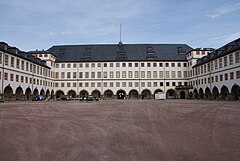Schloss Friedenstein
| Friedenstein Castle | |
|---|---|
| Schloss Friedenstein | |

View from the courtyard towards the north wing
|
|
|
Location of Friedenstein Castle in Germany
|
|
| General information | |
| Type | Palace |
| Architectural style | Early Baroque |
| Town or city | Gotha |
| Country | Germany |
| Coordinates | 50°56′45″N 10°42′16″E / 50.945833°N 10.704444°E |
| Construction started | 1643 |
| Completed | 1656 (initial work) |
| Client | Herzog Ernst I von Sachsen-Gotha (Ernest I of Saxe-Gotha) |
| Owner | Stiftung Thüringer Schlösser und Gärten |
| Design and construction | |
| Architect | Casper Vogell |
| Structural engineer | Andreas Rudolph |
Friedenstein Castle (German: Schloss Friedenstein) is an early Baroque palace built in the mid-17th century by Ernest I, Duke of Saxe-Gotha at Gotha, Thuringia, Germany. In Germany, Friedenstein was one of the largest palaces of its time and one of the first Baroque palaces ever built. Friedenstein served as the main seat of the Dukes of Saxe-Gotha and later as one of the residences of the Dukes of Saxe-Coburg and Gotha, closely linked with the Royal Family of Great Britain through the marriage of Queen Victoria and Prince Albert. The final two ruling Dukes were both princes of the United Kingdom.
The castle complex today houses several museums. It is also notable for hosting the Ekhof-Theater, one of the oldest theatres in operation in Germany, still featuring the original Baroque machinery for changing the scenery.
The site where Friedenstein stands today, dominating the town of Gotha and its surroundings, was previously occupied by Grimmenstein Castle. It was first mentioned in 1316 and rebuilt in 1531-43 when it was also fortified in accordance with the changed requirements for a fortress in the age of gunpowder. In 1547, the Ernestine branch of the House of Wettin as members of the Protestant Schmalkaldic League had lost the Battle of Mühlberg against the Catholic forces of Emperor Charles V. As a result, Johann Friedrich I, Kurfürst von Sachsen (John Frederick I) was stripped of his title as "Elector of Saxony" ( Kurwürde ). Imperial forces blew up the fortifications of Grimmenstein but left the castle itself largely intact. It was rebuilt in 1552-54. However, in 1567 the fortress was almost completely razed as a result of the attempt of Johann Friedrich II (John Frederick II) to regain the Kurwürde by force of arms.
...
Wikipedia

